check engine light MERCEDES-BENZ B-CLASS HATCHBACK 2008 User Guide
[x] Cancel search | Manufacturer: MERCEDES-BENZ, Model Year: 2008, Model line: B-CLASS HATCHBACK, Model: MERCEDES-BENZ B-CLASS HATCHBACK 2008Pages: 305, PDF Size: 5.1 MB
Page 178 of 305
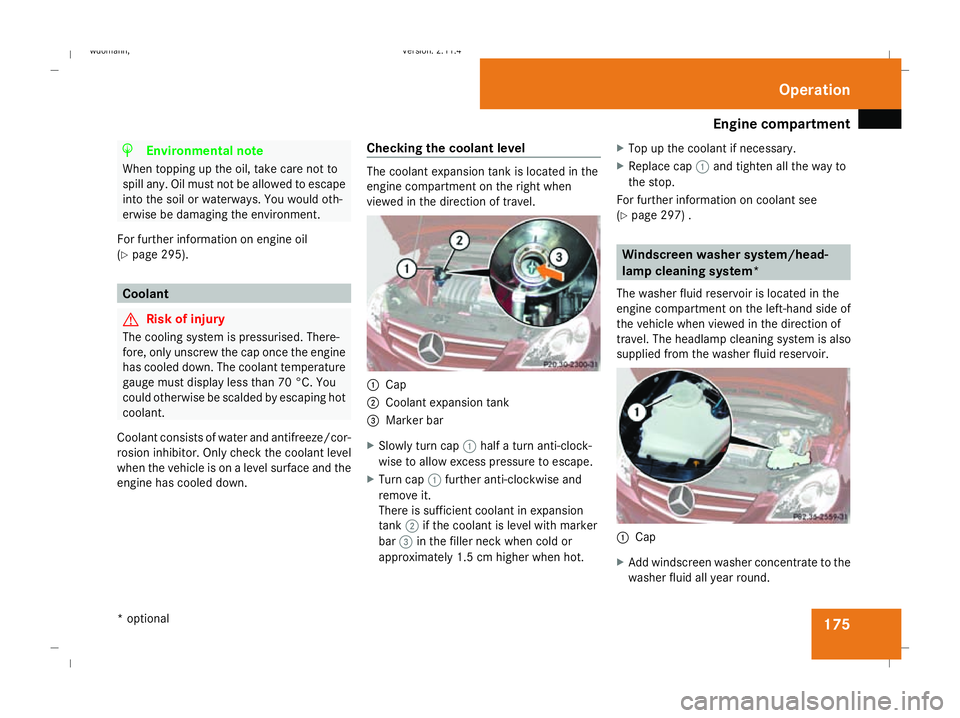
Engine compartment
175H
Environmental note
When topping up the oil, take care not to
spill any. Oil must not be allowed to escape
into the soil or waterways. You would oth-
erwise be damaging the environment.
For further information on engine oil
(Y page 295). Coolant
G
Risk of injury
The cooling system is pressurised. There-
fore, only unscrew the cap once the engine
has cooled down. The coolant temperature
gauge must display less than 70 °C. You
could otherwise be scalded by escaping hot
coolant.
Coolant consists of water and antifreeze/cor-
rosion inhibitor. Only check the coolant level
when the vehicle is on a level surface and the
engine has cooled down. Checking the coolant level The coolant expansion tank is located in the
engine compartment on the right when
viewed in the direction of travel.
1
Cap
2 Coolant expansion tank
3 Marker bar
X Slowly turn cap 1half a turn anti-clock-
wise to allow excess pressure to escape.
X Turn cap 1further anti-clockwise and
remove it.
There is sufficient coolant in expansion
tank 2if the coolant is level with marker
bar 3in the filler neck when cold or
approximately 1.5 cm higher when hot. X
Top up the coolant if necessary.
X Replace cap 1and tighten all the way to
the stop.
For further information on coolant see
(Y page 297) . Windscreen washer system/head-
lamp cleaning system*
The washer fluid reservoir is located in the
engine compartment on the left-hand side of
the vehicle when viewed in the direction of
travel. The headlamp cleaning system is also
supplied from the washer fluid reservoir. 1
Cap
X Add windscreen washer concentrate to the
washer fluid all year round. Operation
* optional
245_AKB; 2; 7, en-GB
wdomann
,V ersion: 2.11.4
2008-10-17T11:22:31+02:00 - Seite 175 ZDateiname: 6515_1640_02_buchblock.pdf; preflight
Page 185 of 305
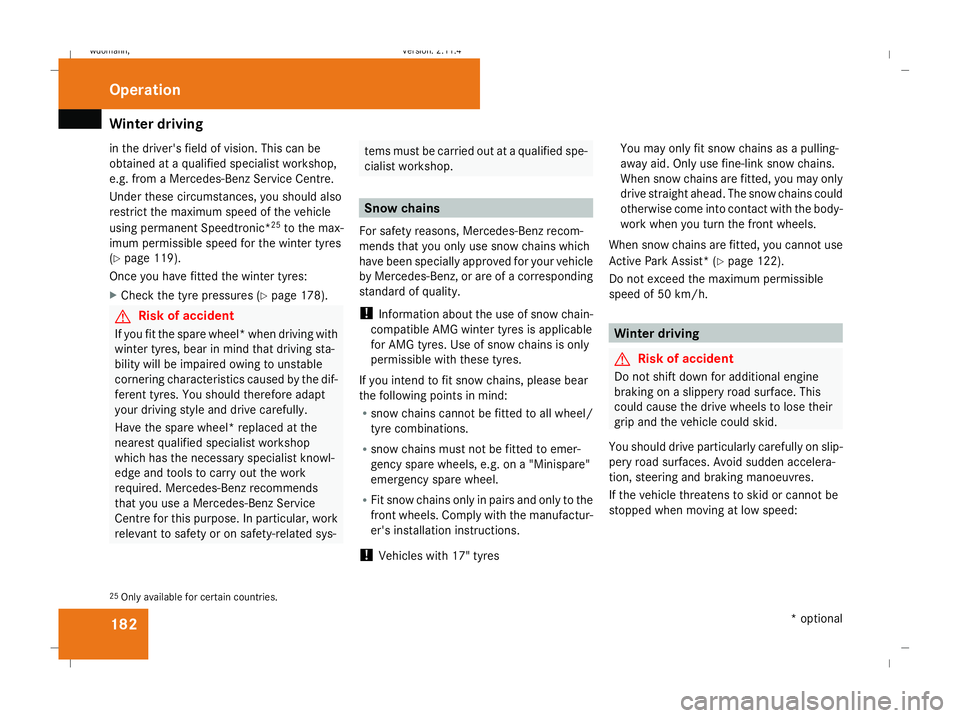
Winter driving
182
in the driver's field of vision. This can be
obtained at a qualified specialist workshop,
e.g. from a Mercedes-Benz Service Centre.
Under these circumstances, you should also
restrict the maximum speed of the vehicle
using permanent Speedtronic* 25
to the max-
imum permissible speed for the winter tyres
(Y page 119).
Once you have fitted the winter tyres:
X Check the tyre pressures (Y page 178).G
Risk of accident
If you fit the spare wheel* when driving with
winter tyres, bear in mind that driving sta-
bility will be impaired owing to unstable
cornering characteristics caused by the dif-
ferent tyres. You should therefore adapt
your driving style and drive carefully.
Have the spare wheel* replaced at the
nearest qualified specialist workshop
which has the necessary specialist knowl-
edge and tools to carry out the work
required. Mercedes-Benz recommends
that you use a Mercedes-Benz Service
Centre for this purpose. In particular, work
relevant to safety or on safety-related sys- tems must be carried out at a qualified spe-
cialist workshop.
Snow chains
For safety reasons, Mercedes-Benz recom-
mends that you only use snow chains which
have been specially approved for your vehicle
by Mercedes-Benz, or are of a corresponding
standard of quality.
! Information about the use of snow chain-
compatible AMG winter tyres is applicable
for AMG tyres. Use of snow chains is only
permissible with these tyres.
If you intend to fit snow chains, please bear
the following points in mind:
R snow chains cannot be fitted to all wheel/
tyre combinations.
R snow chains must not be fitted to emer-
gency spare wheels, e.g. on a "Minispare"
emergency spare wheel.
R Fit snow chains only in pairs and only to the
front wheels. Comply with the manufactur-
er's installation instructions.
! Vehicles with 17" tyres You may only fit snow chains as a pulling-
away aid. Only use fine-link snow chains.
When snow chains are fitted, you may only
drive straight ahead. The snow chains could
otherwise come into contact with the body-
work when you turn the front wheels.
When snow chains are fitted, you cannot use
Active Park Assist* (Y page 122).
Do not exceed the maximum permissible
speed of 50 km/h. Winter driving
G
Risk of accident
Do not shift down for additional engine
braking on a slippery road surface. This
could cause the drive wheels to lose their
grip and the vehicle could skid.
You should drive particularly carefully on slip-
pery road surfaces. Avoid sudden accelera-
tion, steering and braking manoeuvres.
If the vehicle threatens to skid or cannot be
stopped when moving at low speed:
25 Only available for certain countries. Operation
* optional
245_AKB; 2; 7, en-GB
wdomann,
Version: 2.11.4 2008-10-17T11:22:31+02:00 - Seite 182Dateiname: 6515_1640_02_buchblock.pdf; preflight
Page 212 of 305
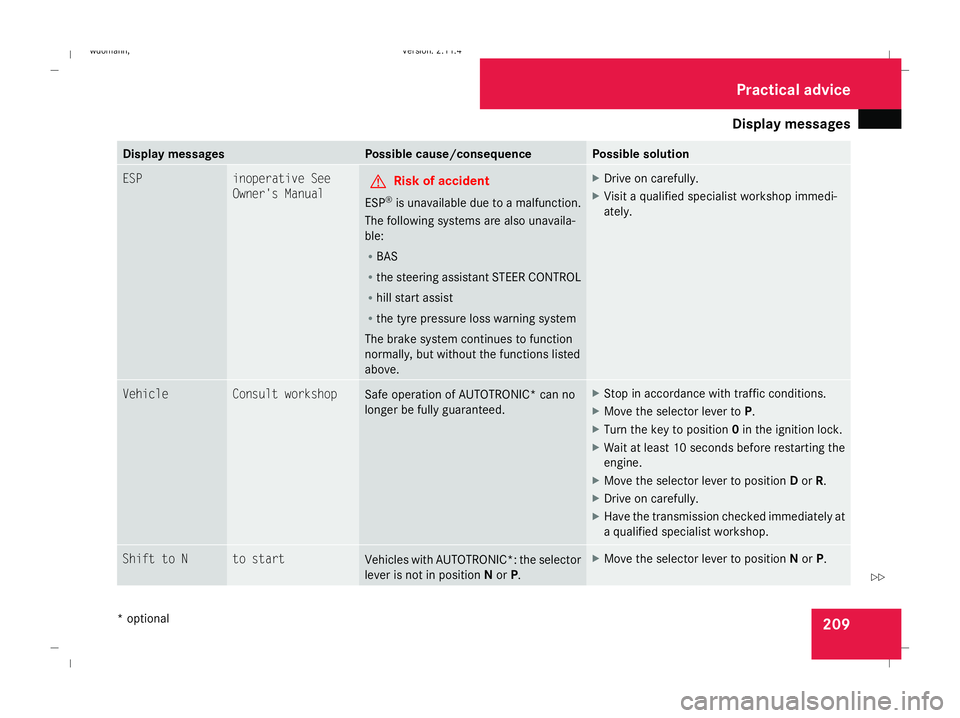
Display
messages 209Display messages Possible cause/consequence Possible solution
ESP inoperative See
Owner's Manual G
Risk of accident
ESP ®
is unavailable due to a malfunction.
The following systems are also unavaila-
ble:
R BAS
R the steering assistant STEER CONTROL
R hill start assist
R the tyre pressure loss warning system
The brake system continues to function
normally, but without the functions listed
above. X
Drive on carefully.
X Visit a qualified specialist workshop immedi-
ately. Vehicle Consult workshop
Safe operation of AUTOTRONIC* can no
longer be fully guaranteed. X
Stop in accordance with traffic conditions.
X Move the selector lever to P.
X Turn the key to position 0in the ignition lock.
X Wait at least 10 seconds before restarting the
engine.
X Move the selector lever to position Dor R.
X Drive on carefully.
X Have the transmission checked immediately at
a qualified specialist workshop. Shift to N to start
Vehicles with AUTOTRONIC*: the selector
lever is not in position
Nor P. X
Move the selector lever to position Nor P. Practical advi
ce
* optional
245_AKB; 2; 7, en-GB
wdomann,
Version: 2.11.4 2008-10-17T11:22:31+02:00 - Seite 209 ZDateiname: 6515_1640_02_buchblock.pdf; preflight
Page 216 of 305

Display
messages 213Display messages Possible cause/consequence Possible solution
D The engine fan is faulty. X
If the coolant temperature is less than 120 †,
you can continue driving to the nearest quali-
fied specialist workshop.
X Avoid subjecting the engine to heavy loads, e.g.
driving in mountainous terrain, and stop-and-
go driving. # The battery is not being charged. One (or
more) of the following could be the cause:
R
a faulty alternator
R a torn poly-V-belt
R a malfunction in the electronics X
Stop immediately and safely when traffic con-
ditions permit and switch off the engine.
X Check the poly-V-belt.
X If the poly-V-belt is torn: do not continue
driving. Consult a qualified specialist work-
shop.
X If the poly-V-belt is not damaged: have the
vehicle checked immediately at a qualified spe-
cialist workshop. The on-board voltage is too high. X
Have the alternator checked at a qualified spe-
cialist workshop. 2 Brake wear The brake pads/linings have reached
their wear limit. X
Visit a qualified specialist workshop. Practical advi
ce
245_AKB; 2; 7, en-GB
wdomann,
Version: 2.11.4 2008-10-17T11:22:31+02:00 - Seite 213 ZDateiname: 6515_1640_02_buchblock.pdf; preflight
Page 217 of 305
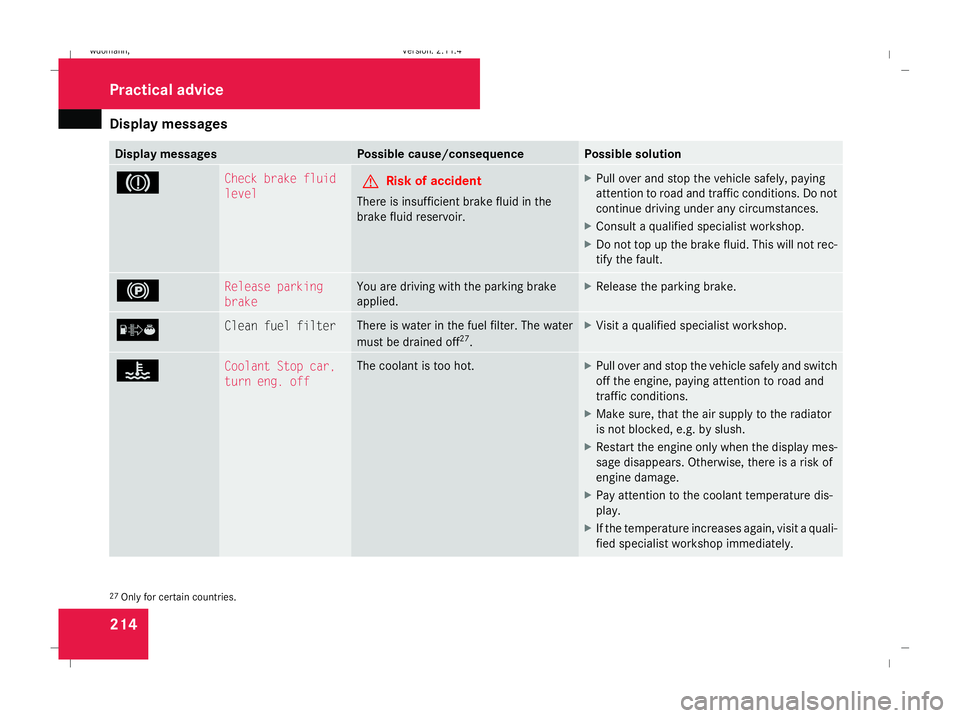
Display
messages 214 Display messages Possible cause/consequence Possible solution
3 Check brake fluid
level
G
Risk of accident
There is insufficient brake fluid in the
brake fluid reservoir. X
Pull over and stop the vehicle safely, paying
attention to road and traffic conditions. Do not
continue driving under any circumstances.
X Consult a qualified specialist workshop.
X Do not top up the brake fluid. This will not rec-
tify the fault. ! Release parking
brake You are driving with the parking brake
applied. X
Release the parking brake. [ Clean fuel filter There is water in the fuel filter. The water
must be drained off
27
. X
Visit a qualified specialist workshop. D Coolant Stop car,
turn eng. off The coolant is too hot. X
Pull over and stop the vehicle safely and switch
off the engine, paying attention to road and
traffic conditions.
X Make sure, that the air supply to the radiator
is not blocked, e.g. by slush.
X Restart the engine only when the display mes-
sage disappears. Otherwise, there is a risk of
engine damage.
X Pay attention to the coolant temperature dis-
play.
X If the temperature increases again, visit a quali-
fied specialist workshop immediately. 27
Only for certain countries. Practical advi
ce
245_AKB; 2; 7, en-GB
wdomann,
Version: 2.11.4 2008-10-17T11:22:31+02:00 - Seite 214Dateiname: 6515_1640_02_buchblock.pdf; preflight
Page 218 of 305
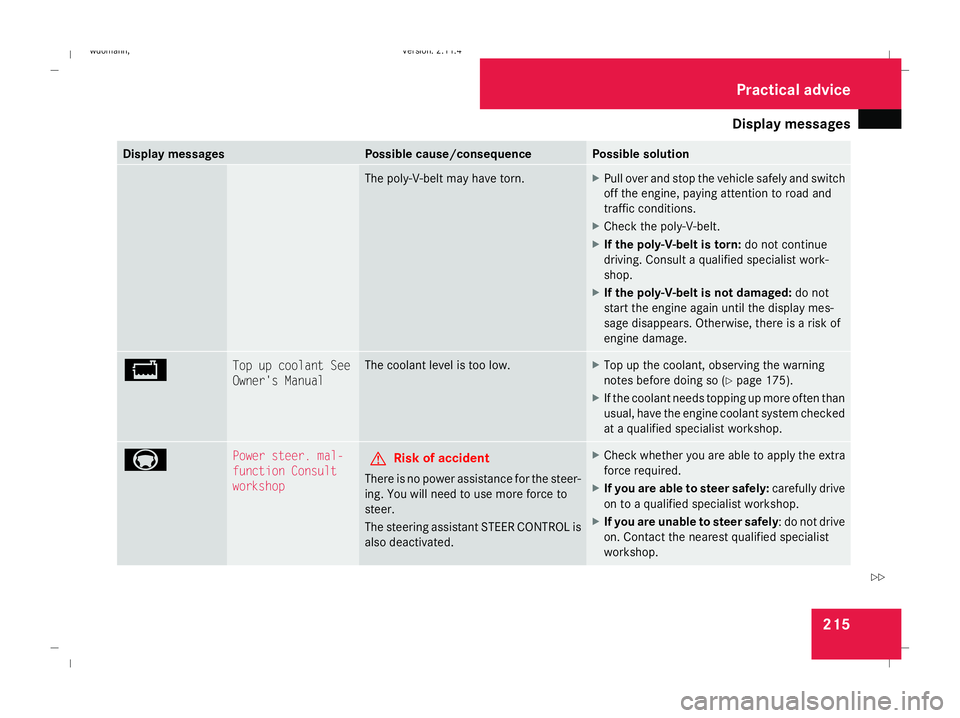
Display
messages 215Display messages Possible cause/consequence Possible solution
The poly-V-belt may have torn. X
Pull over and stop the vehicle safely and switch
off the engine, paying attention to road and
traffic conditions.
X Check the poly-V-belt.
X If the poly-V-belt is torn: do not continue
driving. Consult a qualified specialist work-
shop.
X If the poly-V-belt is not damaged: do not
start the engine again until the display mes-
sage disappears. Otherwise, there is a risk of
engine damage. B Top up coolant See
Owner's Manual The coolant level is too low. X
Top up the coolant, observing the warning
notes before doing so (Y page 175).
X If the coolant needs topping up more often than
usual, have the engine coolant system checked
at a qualified specialist workshop. 3 Power steer. mal-
function Consult
workshop G
Risk of accident
There is no power assistance for the steer-
ing. You will need to use more force to
steer.
The steering assistant STEER CONTROL is
also deactivated. X
Check whether you are able to apply the extra
force required.
X If you are able to steer safely: carefully drive
on to a qualified specialist workshop.
X If you are unable to steer safely : do not drive
on. Contact the nearest qualified specialist
workshop. Practical advi
ce
245_AKB; 2; 7, en-GB
wdomann,
Version: 2.11.4 2008-10-17T11:22:31+02:00 - Seite 215 ZDateiname: 6515_1640_02_buchblock.pdf; preflight
Page 222 of 305
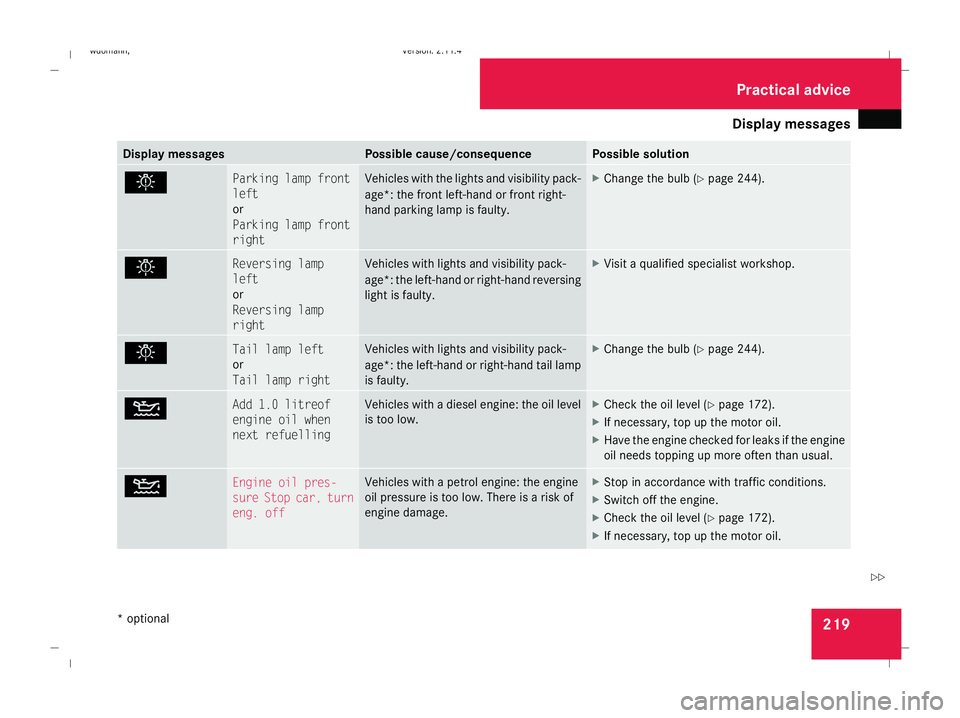
Display
messages 219Display messages Possible cause/consequence Possible solution
. Parking lamp front
left
or
Parking lamp front
right Vehicles with the lights and visibility pack-
age*: the front left-hand or front right-
hand parking lamp is faulty. X
Change the bulb (Y page 244). . Reversing lamp
left
or
Reversing lamp
right Vehicles with lights and visibility pack-
age*: the left-hand or right-hand reversing
light is faulty. X
Visit a qualified specialist workshop. . Tail lamp left
or
Tail lamp right Vehicles with lights and visibility pack-
age*: the left-hand or right-hand tail lamp
is faulty. X
Change the bulb (Y page 244). N Add 1.0 litreof
engine oil when
next refuelling Vehicles with a diesel engine: the oil level
is too low. X
Check the oil level (Y page 172).
X If necessary, top up the motor oil.
X Have the engine checked for leaks if the engine
oil needs topping up more often than usual. N Engine oil pres-
sure Stop car, turn
eng. off Vehicles with a petrol engine: the engine
oil pressure is too low. There is a risk of
engine damage. X
Stop in accordance with traffic conditions.
X Switch off the engine.
X Check the oil level (Y page 172).
X If necessary, top up the motor oil. Practical advi
ce
* optional
245_AKB; 2; 7, en-GB
wdomann,
Version: 2.11.4 2008-10-17T11:22:31+02:00 - Seite 219 ZDateiname: 6515_1640_02_buchblock.pdf; preflight
Page 223 of 305
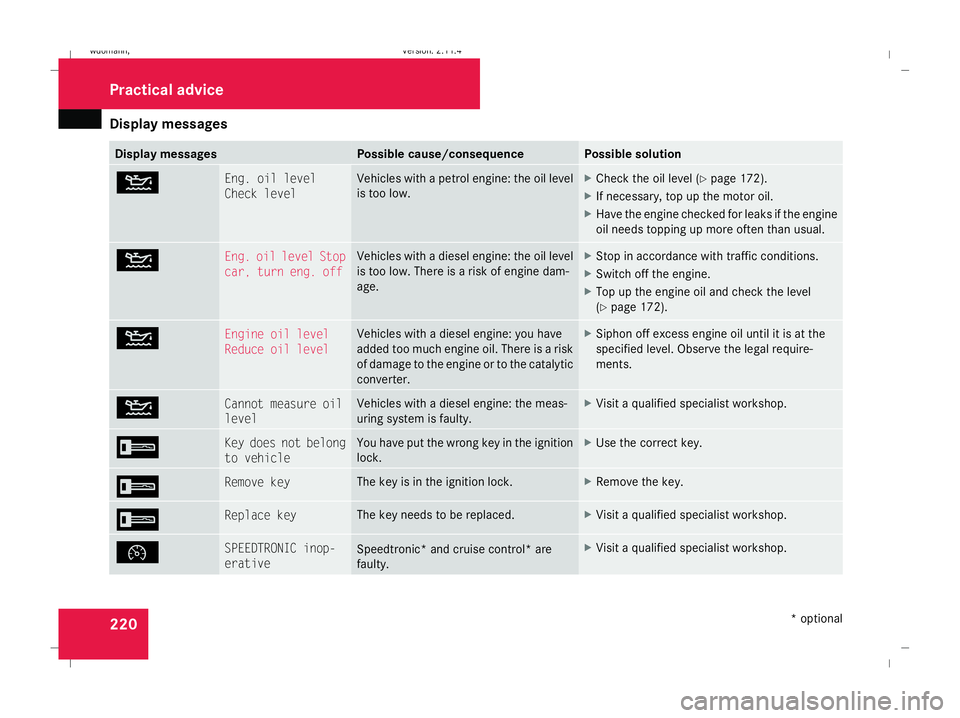
Display
messages 220 Display messages Possible cause/consequence Possible solution
N Eng. oil level
Check level Vehicles with a petrol engine: the oil level
is too low. X
Check the oil level (Y page 172).
X If necessary, top up the motor oil.
X Have the engine checked for leaks if the engine
oil needs topping up more often than usual. N Eng. oil level Stop
car, turn eng. off Vehicles with a diesel engine: the oil level
is too low. There is a risk of engine dam-
age. X
Stop in accordance with traffic conditions.
X Switch off the engine.
X Top up the engine oil and check the level
(Y page 172). N Engine oil level
Reduce oil level Vehicles with a diesel engine: you have
added too much engine oil. There is a risk
of damage to the engine or to the catalytic
converter. X
Siphon off excess engine oil until it is at the
specified level. Observe the legal require-
ments. N Cannot measure oil
level Vehicles with a diesel engine: the meas-
uring system is faulty. X
Visit a qualified specialist workshop. I Key does not belong
to vehicle You have put the wrong key in the ignition
lock. X
Use the correct key. I Remove key The key is in the ignition lock. X
Remove the key. I Replace key The key needs to be replaced. X
Visit a qualified specialist workshop. Ñ SPEEDTRONIC inop-
erative
Speedtronic* and cruise control* are
faulty. X
Visit a qualified specialist workshop. Practical advi
ce
* optional
245_AKB; 2; 7, en-GB
wdomann,
Version: 2.11.4 2008-10-17T11:22:31+02:00 - Seite 220Dateiname: 6515_1640_02_buchblock.pdf; preflight
Page 230 of 305
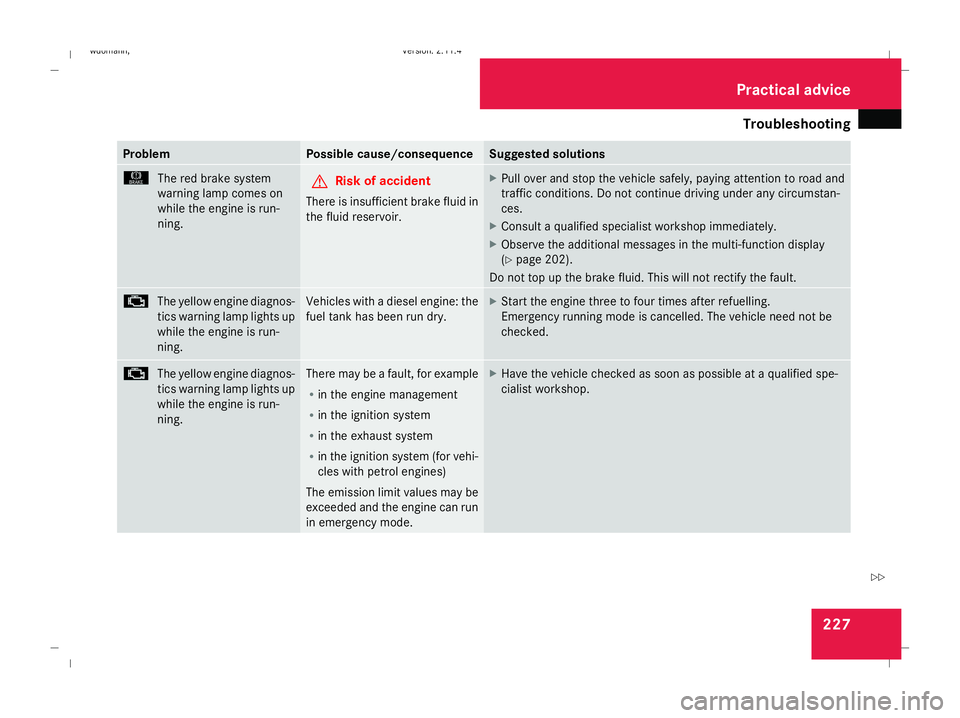
Troubleshooting
227Problem Possible cause/consequence Suggested solutions
H
The red brake system
warning lamp comes on
while the engine is run-
ning. G
Risk of accident
There is insufficient brake fluid in
the fluid reservoir. X
Pull over and stop the vehicle safely, paying attention to road and
traffic conditions. Do not continue driving under any circumstan-
ces.
X Consult a qualified specialist workshop immediately.
X Observe the additional messages in the multi-function display
(Y page 202).
Do not top up the brake fluid. This will not rectify the fault. ±
The yellow engine diagnos-
tics warning lamp lights up
while the engine is run-
ning. Vehicles with a diesel engine: the
fuel tank has been run dry. X
Start the engine three to four times after refuelling.
Emergency running mode is cancelled. The vehicle need not be
checked. ±
The yellow engine diagnos-
tics warning lamp lights up
while the engine is run-
ning. There may be a fault, for example
R
in the engine management
R in the ignition system
R in the exhaust system
R in the ignition system (for vehi-
cles with petrol engines)
The emission limit values may be
exceeded and the engine can run
in emergency mode. X
Have the vehicle checked as soon as possible at a qualified spe-
cialist workshop. Practical advice
245_AKB; 2; 7, en-GB
wdomann,
Version: 2.11.4
2008-10-17T11:22:31+02:00 - Seite 227 ZDateiname: 6515_1640_02_buchblock.pdf; preflight
Page 237 of 305
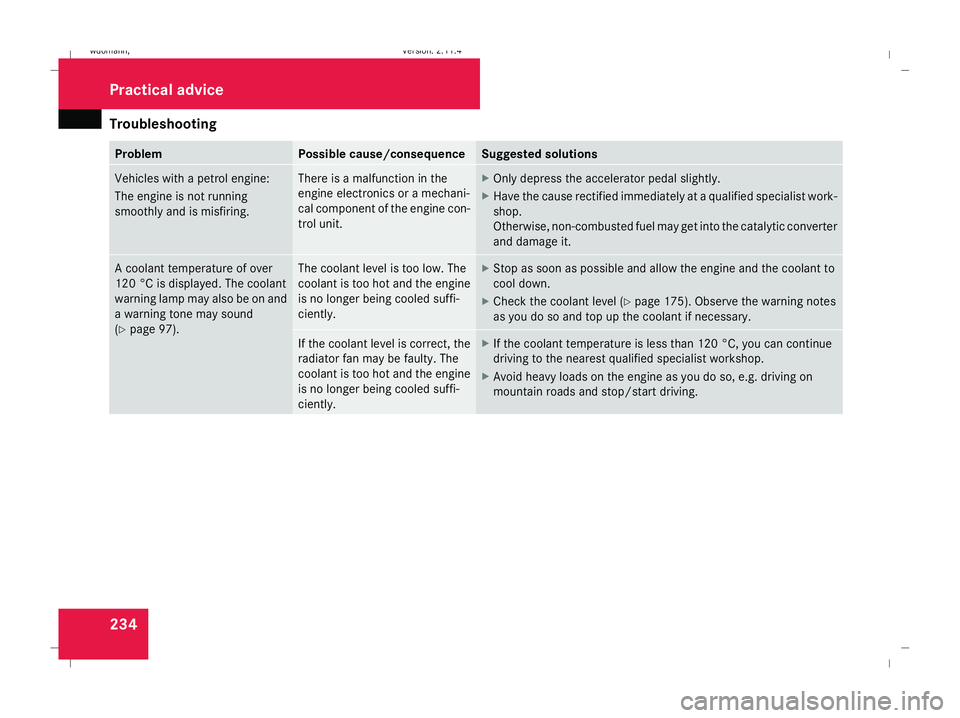
Troubleshooting
234 Problem Possible cause/consequence Suggested solutions
Vehicles with a petrol engine:
The engine is not running
smoothly and is misfiring. There is a malfunction in the
engine electronics or a mechani-
cal component of the engine con-
trol unit. X
Only depress the accelerator pedal slightly.
X Have the cause rectified immediately at a qualified specialist work-
shop.
Otherwise, non-combusted fuel may get into the catalytic converter
and damage it. A coolant temperature of over
120 °C is displayed. The coolant
warning lamp may also be on and
a warning tone may sound
(Y
page 97). The coolant level is too low. The
coolant is too hot and the engine
is no longer being cooled suffi-
ciently. X
Stop as soon as possible and allow the engine and the coolant to
cool down.
X Check the coolant level (Y page 175). Observe the warning notes
as you do so and top up the coolant if necessary. If the coolant level is correct, the
radiator fan may be faulty. The
coolant is too hot and the engine
is no longer being cooled suffi-
ciently. X
If the coolant temperature is less than 120 °C, you can continue
driving to the nearest qualified specialist workshop.
X Avoid heavy loads on the engine as you do so, e.g. driving on
mountain roads and stop/start driving. Practical advice
245_AKB; 2; 7, en-GB
wdomann,
Version: 2.11.4 2008-10-17T11:22:31+02:00 - Seite 234Dateiname: 6515_1640_02_buchblock.pdf; preflight